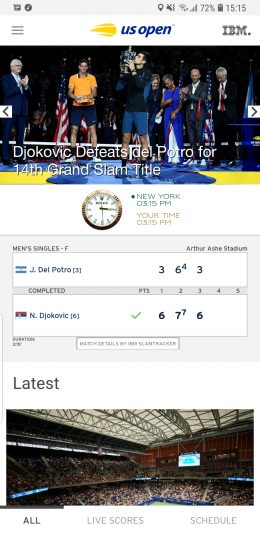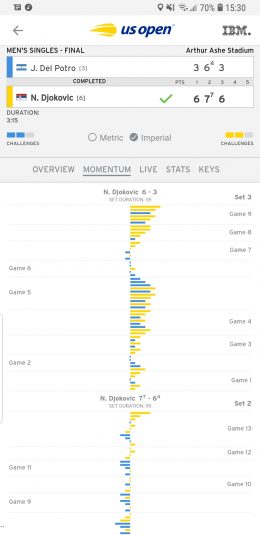Live From the US Open: Digital Products Get Refresh as Experience at Home and in Stands Improves
USTA website and apps are rebuilt from scratch, offer detailed match-centric content
Story Highlights
At the US Open tennis championships, which ended this past weekend, the grounds weren’t the only thing that had been overhauled: digital properties related to the event also had been rebuilt from the ground up.
“We rebuilt all of the digital properties from scratch: the website and the apps,” says Kirsten Corio, managing director, ticketing and digital strategies, USTA. “This was also the first time that we built the Android app from scratch in conjunction with our friends from Google. They helped us with best practices around Android development, so it’s really designed for Android vs. an IOS app fitting into Android.”

For the first time ever, the US Open app for Android was built from the ground up.
The digital strategies continue to serve two masters. The goal is to create offerings that are attractive both to fans at the USTA Billie Jean King National Tennis Center (NTC) and to any other tennis fan around the globe. The sweet spot is match-centric content like video, stats, photos, and stories that can keep fans anywhere up-to-date on the action. Things like a pervasive scoreboard across both the app and the website made it easy for fans to find out what was going on.
“And when you drilled down on the website,” Corio says, “on the right-hand side, you would see all of the detailed stats. IBM SlamTracker even added a momentum score, which keeps track of who is winning points and how that is shifting the momentum. Lines are drawn out from a midline towards the name of a player on either side of the line, and the more consecutive points and games a player wins, the more momentum shifts in their favor. At a glance, a fan can get a sense of how momentum shifted during a match, something that a simple match score of, say, five games to four can’t show.”
The new digital efforts are all part of the USTA’s goal to make the US Open the “innovative slam,” where technology and tennis come together for fans and players alike.
“We have to be constantly iterating and innovating to defend that position,” notes Corio. “Nowhere is that more obvious than in our digital properties.”
Part of those efforts are a rebuild of everything every two years to ensure that the products evolve as the consumer technologies evolve. With this being the Open’s 50th anniversary, those efforts began in March with a light version that embraced the tournament’s new logo.
The full experience puts scoring front and center and also eliminates dead ends. “Users are dropped into the next story as they get to the end of one,” Corio explains, adding, “There is autoplay of video for the next set of highlights. It’s more of an experience, and users can get lost in it and spend more time than they intended to.”
The app, meanwhile, continued to evolve to meet the needs of fans at the NTC. The grounds map offers a 3D rendering of the grounds, and the use of IBM Watson AI means that fans can ask the Virtual Concierge thousands of questions and get answers. New this year was its availability via Facebook Messenger.

Momentum is a new way to visualize the ebbs and flow of a tennis match.
Overlays on the courts also are helpful for fans onsite. They can tap on a court and see the score pop up instantly. Simply put, the days of craning one’s neck to watch a scoreboard (or sit where one is visible) are over.
“FanCam was in the app for the first time this year,” says Corio. “If you are sitting in Arthur Ashe Stadium, you put in your section and seat location and take control of one of the eight cameras in the catwalk. It maps to your location, and you can pinch and zoom your location and take a picture.”
The Fan Access Pass is also integrated into the app, providing unified registration so that, as fans engage with various experiences, a quick scan of a QR code gets them free gifts and provides valuable data to USTA marketing partners without the fans’s having to re-enter information over and over.
“There is also gamification with a grand prize of tickets to the final,” says Corio, noting, “Last year, 400 people collected every badge.” The gamification can also be done by fans at home.
For those who have an Apple iPhone or iPad, the US Open Matchcast brought AR and live scoring together. Built into the primary app, it delivers a 3D rendering of each of the three primary stadiums and then layers in player avatars and live scoring. A fan could fire up the feature, point their phone at a flat surface like a table, and, looking through the phone, see the 3D rendering on the table. Moving the phone around allows it to be used as a window into an AR environment that allows the points to be viewed from the vantage of the two avatars or anywhere else.
“It’s a bit of a test with IBM to see if we could do it in a lightweight way. We wanted to pull up the live experience in a way that hasn’t been done before,” says Corio. “You can watch a whole match that way, and, although it looks like pong, it’s a cool activation and proof of concept.”
Of all the changes, probably the biggest is that the digital team, which works in the Indoor Tennis Center, is now tied in via fiber to the broadcast-production team, which is located in the broadcast compound behind Arthur Ashe Stadium. That means the team can more easily access and publish content, because an EVS IPDirector can dive into the content storage and access the desired content.
“Utopia would be for all of us to get in the same place so that we can physically be in the same place,” says Corio.
Next year will see continued improvement to the digital experience, and, while some of it might not be obvious to the user, the experience will be faster and easier.
“We also get itchy and antsy and see what other people, like the PGA or NBA, are doing and want to see how we can bring them to life in interesting ways for our fans,” says Corio. “We don’t want to rest on our laurels.”
CLICK HERE to check out all of SVG’s “Live From the US Open 2018” coverage.
